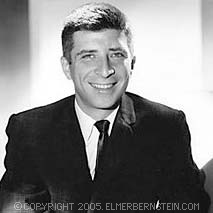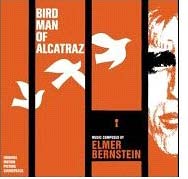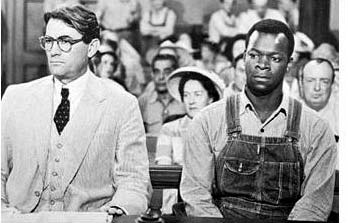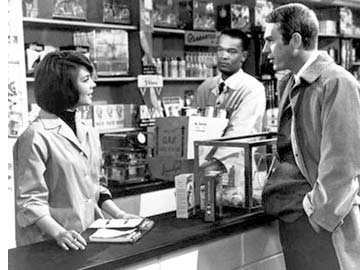














  |
|

Drama & Comedy Scores
If the 1950s represent Elmer Bernstein's meteoric rise to the A-list of film composers, the decade that followed only confirmed that this man's talents seemed to have no limits. Between 1960 and 1969, he produced a staggering number of great scores in as many different genres, demonstrating unlimited creativity and mastery of his craft. By 1960, moviegoers were now searching for Elmer's name in the credits of theater lobby posters and newspaper movie listings. Music By Elmer Bernstein was something wonderful to anticipate, and when experienced in a darkened theater, his music was something to revel in. Whatever the film, we were assured that Elmer would take us through an emotional journey or a thrill ride propelled by an orchestra locked to his baton. Leaving the theater, those stirring melodies would still resonate in our heads. Then, we'd search the local record store for the film's soundtrack in the hopes that we could take the LP home, slip open its cellophane, slide the record from its paper sheath and lay it on the turntable, gently setting the diamond to vinyl. The Main Title. The Love Theme. The Action cues. The Finale. And of course we'd have to play some cues over and over because they were so great--until a disgruntled family member would tell us to turn the music down. produced a staggering number of great scores in as many different genres, demonstrating unlimited creativity and mastery of his craft. By 1960, moviegoers were now searching for Elmer's name in the credits of theater lobby posters and newspaper movie listings. Music By Elmer Bernstein was something wonderful to anticipate, and when experienced in a darkened theater, his music was something to revel in. Whatever the film, we were assured that Elmer would take us through an emotional journey or a thrill ride propelled by an orchestra locked to his baton. Leaving the theater, those stirring melodies would still resonate in our heads. Then, we'd search the local record store for the film's soundtrack in the hopes that we could take the LP home, slip open its cellophane, slide the record from its paper sheath and lay it on the turntable, gently setting the diamond to vinyl. The Main Title. The Love Theme. The Action cues. The Finale. And of course we'd have to play some cues over and over because they were so great--until a disgruntled family member would tell us to turn the music down.
Before the advent of VHS tapes and DVDs, movie soundtracks were the media we used to relive our favorite films. The music spoke to us about a favorite actor, character, or a favorite scene. When we listened to To Kill a Mockingbird, we remembered with such clarity the moment when Atticus shook Arthur Radley's hand, or when Steve McQueen drew his gun, squeezed off some shots, then jumped through a barricade for cover, or when Peter Sellars nervously looked over his shoulder for an irate husband or two pesky kids, or when the sea going missionaries first laid eyes on the Hawaiian Islands. Soundtracks became the ultimate conductor of visual memory. And even though I own dozens of DVDs of films scored by Elmer, I still love to listen to the original soundtracks.
Selecting what I think are EB's best scores from the 1960s was a challenging task. Tomorrow, I might just as easily assemble a different list. But I suppose these scores are the ones that never fail to move me--either on record or within the films for which they were composed.
To Kill a Mockingbird (1962).
 Elmer's masterwork and one of the best film scores ever written. I can't think of any other American film where music fits so perfectly and unobtrusively and yet carries such honest and powerful emotion than this landmark score. It's as if Elmer climbed inside the psyche and imaginative world of a child and captured the essence of joy, wonderment, fear, and heroism with his music. Elmer's masterwork and one of the best film scores ever written. I can't think of any other American film where music fits so perfectly and unobtrusively and yet carries such honest and powerful emotion than this landmark score. It's as if Elmer climbed inside the psyche and imaginative world of a child and captured the essence of joy, wonderment, fear, and heroism with his music.
Main Title. Watching the opening credits to this film I'm suddenly reminded why I miss main title sequences so much these days. Film artists and technicians used to design wonderfully effective credit sequences to draw us into the film, such as Maurice Binder's swirling concentric arrows in Charade, or Saul Bass' hand in closeup tearing away pieces of black paper, revealing the credits in Bunny Lake is Missing. In Mockingbird, credits designer Stephen Frankfurt and composer Elmer Bernstein created what has to be one of the best main title sequences ever; like a child playing a one-hand piano exercise, Elmer's main theme comes in quietly. In extreme closeup, we observe a child's hand opening a cigar box filled with childhood treasures--soap dolls, a pocket watch, marbles, crayons. Woodwinds take up the melody, supported by harp arpeggios and an accordion, which swells into the full orchestral version of the main theme. Admittedly, I still get chills when the dollying camera stops on a metal whistle and the title fades up: Music-Elmer Bernstein. EB's theme is exquisite--it captures the carefree days of childhood, the haunting beauty of life in a small Southern town, where mysteries loom, and foreshadows the empathy and compassion the characters will feel as their lives are changed forever.

Roll in the Tire. Early in the film, after Atticus has agreed to defend Tom Robinson, who has been accused of raping the daughter of a white racist, we get a glimpse into the daily lives of Atticus' two children, Jem and Scout. The following morning, the needling siblings invite their neighbor, Dill (patterned after Truman Capote as a child), to "roll in the tire," a game that requires you to fold yourself up into the inside of an old automobile tire, and let your friends send you rolling down the street. As the kids first come barreling out the door into the front yard, Elmer's music summons the easy days of summer when all you had was time and your imagination.

The cue bounces along like a country hoedown, with a wonderfully rapid string sequence. Scout takes the first turn, but when the tire's path slams her into the front steps of Boo Radley's house, Bernstein gives us one of his best menacing cues: strings and woodwinds play a unison whole note, while the brass answers with a major seventh of the root, an octave lower. The first whole note is repeated, this time answered by a minor seventh of the root, also an octave lower. The dissonance this creates is extremely effective given the mystery of who or what lives in the Radley house. As the kids run for their lives, Elmer reprises the tire theme, only this time with descending brass figures signifying their escape.
Mr. Arthur. Near the film's end, an unidentified man rescues the children from an assault by the racist and carries an injured Jem home to safety. These scenes cut to Jem and Scout's bedroom, where the boy lies unconcious, his arm in a splint. As Scout spies a cowering man behind the bedroom door, there is a beautifully slow expression of recognition on her face as she realizes that their protector is Boo Radley. Elmer's leitmotif begins slowly with accordion and woodwinds, melding delicately into a kind of child's lullaby, perfectly underscoring Scout's epiphany and Radley's "shy ways." Honestly, when Scout says, "Hey Boo" to Arthur Radley (played brilliantly by Robert Duvall), I don't know of anyone who can get through this scene without holding back a deluge of tears.

Moments later, on the front porch, Atticus extends his hand to Radley saying, "thank you Arthur, thank you for my children." This sequence is embellished by what I like to call Bernstein's denouement (or finale) music. No-one from this period in American film could score the summation of a film like Elmer. Here, the strings walk up to a major seventh chord while the woodwinds play half-noted open intervals. Then, as Scout walks Arthur home, EB brings in the opening strains of the main theme, arranged for accordion, harp, and woodwinds, then the full orchestra. So ends this masterpiece of film making and film scoring. I believe the original CD soundtrack (Mainstream Records: MDCD 602) is the best representation of this music, although the score has been re-recorded multiple times with much better fidelity.
The Birdman of Alcatraz (1962).
Elmer's delicate score to this outstanding film adaptation of life-long prisoner and world-renowned bird expert, Robert Stroud, proves beyond a shadow of a doubt that the Golden Age of film music is over. Here, as in other films of the early 60s, the big symphony orchestra is replaced by a chamber-sized ensemble that applies a less is more approach. Just as Bernstein used the solo piano in To Kill a Mockingbird to portray the world through a child's eyes, so too does he use solo woodwinds--piccolos, flutes, oboes, and bassoons--to capture Stroud's solitary inner world and his precious birds. The film has many extended quiet passages where we watch Stroud (Burt Lancaster) with the birds--observing them in the prison yard, fabricating cages out of wooden crates, or training one to pull a tiny cart. Elmer's music quietly joins in perfect harmony, the woodwinds flittering about playfully like the sparrows in Stroud's cell. It's amazing that this is the same composer who could create a testosterone-driven Western theme like The Magnificent Seven. What range.
Bernstein also uses an effective brass fanfare leitmotif, not unlike Copland's Fanfare for the Common Man, to underscore the trials of a man condemned to spend his life in prison, but continuing to defy the authority that keeps him there (spacious voicing and perfect fourths and fifths are a common Bernstein-ism). These interludes have a very documentary feel to them and are reminiscent of the composer's music for the National Geographic series. Altogether, the music is passionate without being sentimental, and can easily be heard as an underscore for Stroud's studied intellect.

Walk on the Wild Side (1962).
By 1962 Elmer Bernstein had scored American cinema's biggest religious epic, the first all jazz score, had redefined the sound of the modern Western, and joined Alex North in conquering the Tennessee Williams drama. With Walk on the Wild Side, Elmer gives us a Cajun stew of sensual bordello music and exhilarating Dixieland jazz that is so evocative of the underside of the 1930s French Quarter that the film is almost superfluous. Opening credits designer Saul Bass and Bernstein create one of the all-time best main title sequences as we observe a method acting cat slinking through a dark alley. Elmer's music begins with a syncopated, ringing triangle, followed by a funky standup bass line and assorted percussion, exploding with a sweeping string glissando into a powerful theme song that is among the composer's best. The pounding tympani alone are enough to lift you out of your seat, but Elmer takes you through the melody a couple of times, giving the tune different treatments, then builds to a crescendo and modulates to a new key, whereupon the brass section blasts out the final verse. Fittingly, the tune ends as it started, with the standup bass and triangle and a long fade out. It's kind of like a music video and should be watched over and over.

As for the film that inspires all of this, Walk on the Wild Side is not all that great, with badly miscast Lawrence Harvey and Capucine and a banal storyline about prostitution with cliches coming at you right and left (imagine Breakfast at Tiffany's with a brothel). My recommendation is to rent the DVD, enjoy the opening credits, and then buy the superb CD soundtrack. One cue, "Rejected" is particularly haunting, with its descending mournful sax figures against beautiful string chords. Just as you think it's going to fade, the coda launches into the main theme again. Also memorable are the source music cues--a jazz combo that's absolutely cooking on tunes like Doll House, Hally's Jazz, Kitty, and a jazz/Dixieland version of the main theme that will make you think you're in Preservation Hall, wet from the heat, and listening to the old veteran players laying it down. There's hardly another Bernstein soundtrack around that better exemplifies the composer's amazing versatility with musical genres.
Love With the Proper Stranger (1963).
 You know from the first few strains of the single oboe against diminished 7th arpeggios on harp that Bernstein's music is going to be a winner. In fact, the music completely underscores this opening sequence where musicians straggle into the union hall to pick up some gigs. Starting very quietly, the music gradually builds into a crescendo as the hall fills noisily with job seekers. Elmer's theme swells into a kind of romantic concerto for solo piano and orchestra, presaging the joys and sorrows of two "strangers" who are linked by a careless sexual encounter: McQueen's laid back, rambling musician and Natalie Wood's young woman trying to break the bonds of a possessive, protective family. The piece is easily one of Elmer's most beautiful and shows he could hold his own with Henry Mancini when it came to the romantic theme song. You know from the first few strains of the single oboe against diminished 7th arpeggios on harp that Bernstein's music is going to be a winner. In fact, the music completely underscores this opening sequence where musicians straggle into the union hall to pick up some gigs. Starting very quietly, the music gradually builds into a crescendo as the hall fills noisily with job seekers. Elmer's theme swells into a kind of romantic concerto for solo piano and orchestra, presaging the joys and sorrows of two "strangers" who are linked by a careless sexual encounter: McQueen's laid back, rambling musician and Natalie Wood's young woman trying to break the bonds of a possessive, protective family. The piece is easily one of Elmer's most beautiful and shows he could hold his own with Henry Mancini when it came to the romantic theme song.
For an eleven year old, this 60s movie had a most disturbing sequence in it--one that is as indelible as moments in Hitchcock's Vertigo or Sidney Lumet's Fail Safe. Reluctantly, McQueen and Wood seek the help of an illegal abortionist who shows up at the abandoned apartment house with a suitcase full of medical instruments and a blanket which she lays on the floor. It's stirring to watch McQueen process what is about to happen and we applaud when he bursts in on Wood and the abortionist to stop the dangerous procedure. Bernstein and director Robert Mulligan wisely don't use music for the scene until McQueen embraces a hysterical Wood, who lays sobbing in his arms like a rag doll, at which point the theme music comes up very quietly. This segues seamlessly into a two-shot of McQueen and Wood riding in the back of a taxi through a night-time Manhattan cityscape. The romantic theme music swells, becoming one of the most memorable moments in the film.
After years of being one of Bernstein's most sought after unrecorded film scores, Kritzerland released a world premiere soundtrack to Proper Stranger compiled from orginal music masters at Paramount Studios. Together with previously unreleased tracks from A Girl Named Tamiko, this 2009 limited release is a rare treat for EB soundtrack collectors.

Rampage (1963).
Obviously intended to borrow on the success of the much better Howard Hawks film, Hatari, Rampage is riddled with Hemingway-esque cliches about bravery and machismo, starring a somnambulant Robert Mitchum and scene-chewing Jack Hawkins, and has none of the light-hearted and humorous moments of its predecessor. But it does have Elmer's score, and it's a great one. It's so good, that you can almost tune out the movie and enjoy the music on its own, which fades up every time we see extended shots of the game trapper's convoy winding its way through the spectacular Malaysian scenery. This "journey" leitmotif (repeating a I-VI chord progression) makes ample use of native-sounding percussion, wind chimes, a catchy tuned-drum bass line, and woodwinds/brass that carry one of the composer's most catchy melodies.

Another musical highlight is the main title sequence, where Elmer's theme song--the journey leitmotif with vocals--underscores a nice visual montage of animals in a zoo habitat.
Miraculously, in 2011, Lukas Kendall somehow obtained the 1/4-in masters from Warner Bros' vaults and oversaw the release of the entire score on the Intrada label. It's a limited release soundtrack in very high demand.
The World of Henry Orient (1964)
In this wonderful George Roy Hill film, Elmer achieves for teenagers what he did for younger children in To Kill a Mockingbird. His music manages to capture the lives of two teenage girls--one well adjusted and happy (Gilbert), the other a troubled but gifted pianist (Valerie)--and their escapades around Manhattan. From their dashing through Central Park and concocting a kidnapping plot involving Jayne Mansfield, to tormenting an exasperated concert pianist (a hilarious Peter Sellers) trying to have a tryst with a jittery fan (Paula Prentiss), Bernstein perfectly mimics the girls' frenetic energy and penchant for melodrama.

Some of the funniest moments come when Sellars tries to seduce Prentiss and later, Angela Lansbury, Valerie's mother. A wildly over-the-top romantic piano theme segues into a pounding tribal rhythm, making the scenes twice as humorous.
A favorite cue from the film is when Val discovers her mother's affair with Sellars and runs away, walking alone through a snowy Central Park. A strummed acoustic guitar lays chords underneath a wistful melody played on accordion. It so perfectly reflects the girls' fragile heart and her desire for a real family home like Gilbert's. One highlight of the film is when the girls drag their parents to a Henry Orient concert, where Sellars does a masterful turn as a painfully under rehearsed concert pianist. Credit must go to Kenneth Lauber, who actually composed the atonal, avant guard piece that Sellars butchers on the Steinway. At one point Gilbert's aunt whispers, "if this is music, what's that stuff Cole Porter writes?"
Baby, the Rain Must Fall (1965).
Though this film is almost a complete misfire from the usually reliable production and direction team of Pakula/Mulligan, it benefits tremendously from Elmer's jazzy, pumped up rock and soul score. The main title sequence, a closeup tracking shot of asphalt and painted highway lines rushing by, gives Elmer a great visual to lay out his traveling musician music. It kicks off with a romping electric bass line, bongos, drums, then barking brass chords supporting a killer theme played first by double saxes then trumpets. The rest of the underscore is good, but if viewing on DVD, you should fast forward through the musical sequences where McQueen badly lip synchs two songs at the roadhouse with his string band.

But where the film disappoints, the soundtrack release originally on Mainstream Records, is outstanding. The LP/CD is really a collection of mostly instrumental rock and soul tunes arranged by Shorty Rogers featuring a fantastic horn section and Don Peak's slinky electric guitar. The best thing to do is forgo the film and just listen to the rollicking tunes on the album. The recording is so "live" you'll feel like the rockin' brass section is playing in your living room. The CD release of this soundtrack also includes Bernstein's The Caretakers.
Hawaii (1966)
Whenever I listen to the United Artists soundtrack, I always come away with the same conclusion. Elmer successfully invented music that sounds intrinsically Hawaiian--as calibrated through the influence of New England Calvinist missionaries. This was no easy feat, as most Hawaiian and Polynesian music of the time comprised simple folk songs and rhythmic dance music. So I think Elmer wrote as much to the grandeur of the islandscapes as he did to the culture. The main theme heard in the Overture and main titles is easily one of the most powerful, richly melodic pieces of music ever written for films--because it had to be. If you're going to introduce the majesty of Hawaii in Panavision, the music has to be glorious--and it is.

To prepare for this film, as he did for many films, Bernstein took on the role of musicologist to study the music and instruments of Nineteenth Century island culture. Ingeniously, Elmer moves seamlessly from frenetic percussion figures to very Christian-sounding symphonic hymns. Justifiably, this is one of his most popular scores and one I fondly call Elmer's Fourth Symphony.
Other Notable EB Scores from This Period
- The Rat Race (1960). I really love this film because of its gritty and sometimes humorous depiction of a struggling dancer (Debbie Reynolds) and musician (a very effective Tony Curtis) one sweltering summer in New York City. Continuing proof that EB is as good an interpreter of the New York streets as his contemporary, Leonard Bernstein (West Side Story). Great source music throughout, particularly when Curtis auditions with a jazz group, played by Sam Butera & the Witnesses.
- Summer and Smoke (1961). Not quite as well executed as Kazan's masterpiece, A Streetcar Named Desire, Summer and Smoke does have Geraldine Page's critically acclaimed performance, great dialog, dysfunctional characters as only Tennessee Williams can invent, and a magnificent Bernstein score. The main theme is one of Elmer's most hauntingly beautiful compositions. Those opening chords (F#m > C > F#m > Am > Fm) are legendary for EB fans, and the swirling music that conveys Alma's barely contained fantasies about Dr. Buchanan is intoxicating. (Somewhat simplified chords help demonstrate the richness of Alma’s theme and how Bernstein’s use of open intervals returning to a ninth express unrequited love.) The remainder of the score is equally moving, as Bernstein seamlessly shifts between the doctor's hedonism and Alma's repressed emotions. I earnestly recommend picking up the CD soundtrack.

- The Young Doctors (1961). Vastly underrated drama about a conscientious young pathologist (Ben Gazzara) threatening the turf of a senior doctor (Fredric March) clinging to his reputation and position in an urban hospital. It is one of Bernstein's most understated scores, which is refreshing for a medical drama, where storylines can quickly tailspin into soap opera. While I can't recall the central leitmotif, the music is right on target when it comes to embellishing and augmenting the dramatic and romantic scenes. By the way, March is brilliant as always, adding still another memorable role to his impressive body of work, and the black and white cinematography is beautiful. This score is now available with The Caretakers on Varese Sarabande (VCL 0208 1073).
|
|

